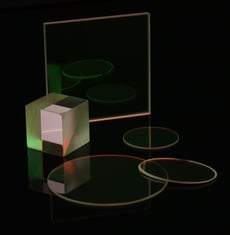 Coating choices must be an integral part of the optical design process, not an afterthought. This article presents four ways you can leverage early coating decisions to improve the final performance and overall cost of your design.
Coating choices must be an integral part of the optical design process, not an afterthought. This article presents four ways you can leverage early coating decisions to improve the final performance and overall cost of your design.
Four Coating Design Tips
1. Get Your Coatings in Order
The sequence of coated optical elements can be critical to system performance, especially for instruments that pick-off or combine wavelengths. Coating materials have different optical properties at different wavelengths, and dielectric coatings may have unwanted behaviors at harmonics of the design wavelength. If these inter-wavelength effects are overlooked, an optical system may not operate as designed.
Analyzing coating performance during preliminary design may reveal element sequences that improve system performance. For example, a strategic design may minimize the use of expensive multi-band filters.
2. Optimize the Design for Coating Performance
Optical design choices affect coating performance. In particular, interference coatings generally become less efficient when
- incident angles deviate from coating design angles, or
- surfaces join materials of similar refractive index.
Consider these factors when choosing surface locations, angles, and curvatures. Simply altering a fold angle, for instance, may improve coating efficiency and allow for a simpler coating design.
3. Choose Stock Optics Carefully
Using stock optics generally reduces cost, but always consider coating performance. Tolerance your coatings just as thoroughly as you tolerance your surfaces. Recoating optics is a painful waste of time and money.
4. Talk to a Coating Engineer Early On
Just because a coating can be designed does not mean that it can be fabricated; and just because a coating can be fabricated does not mean that every coating house can do it. Early in design, identify coating facilities with the right equipment and experience to meet your coating needs.
How Ross Can Help
In response to customer demand, Ross Optical expanded our in-house coating capabilities in 2015. In addition to our previous offerings, we now provide:
- custom coating design and fabrication
- a full wavelength range from UV (250 nm) through near IR (2400 nm)
- many substrates including optical glass, sapphire, fused silica, quartz, silicon, germanium and more
- neutral-density coatings
- interference coatings such as anti-reflection, beamsplitter (polarizing and non-polarizing), bandpass
- turnaround in as little as three days
Give us a call or email sales@rossoptical.com, and talk to a Ross engineer about how we can use our coating capabilities to help improve your optical system performance.
Download Our Tip Sheet: 10 Ways Coating Advancements Can Improve Optical System Performance




